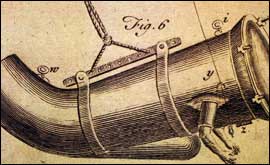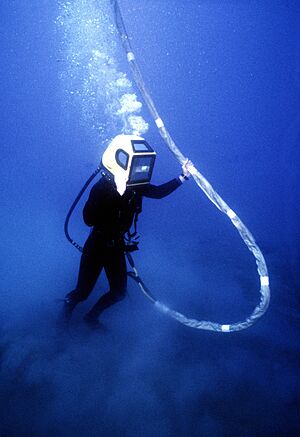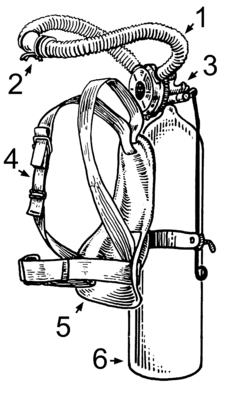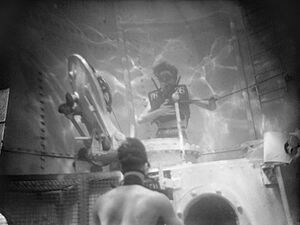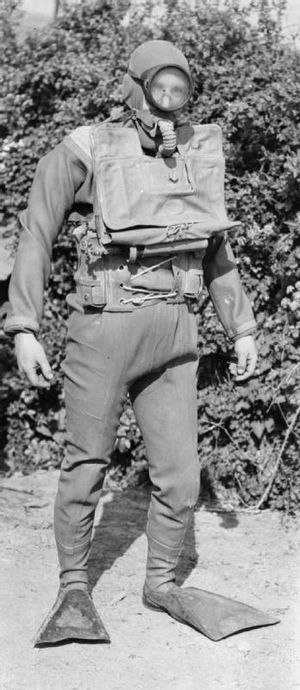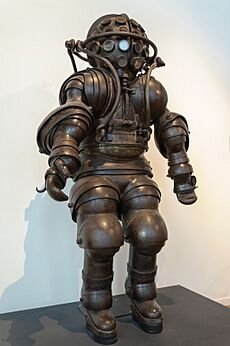History of underwater diving facts for kids

Have you ever wondered how people explored the underwater world before modern scuba gear? The history of underwater diving is a long and exciting journey! It started with people holding their breath to find food or treasures like pearls and coral. Over time, people invented amazing tools to help them stay underwater longer and go deeper. From simple diving bells to complex suits and breathing machines, each invention helped us learn more about the ocean. Diving has been used for many things, like finding sunken ships, helping in wars, and even just for fun. Let's explore how diving technology has changed through the ages!
Contents
Freediving: Diving Without Gear
For a very long time, the only way to dive underwater was by holding your breath. This is called freediving or breath-hold diving. Ancient cultures used this method to gather food, find valuable things like pearls and coral, and even salvage items from sunken ships. Sometimes, they used simple reed snorkels in shallow water. For deeper dives, they would use heavy stones called skandalopetra to help them sink faster.
In Ancient Greece, people started diving for business, especially to collect sponges. The island of Kalymnos was famous for its sponge divers. These divers would hold their breath and use a 15 kg (33 lb) stone to quickly go down to depths of up to 30 meters (100 feet). They could stay underwater for as long as five minutes to collect sponges. Besides sponges, divers also looked for valuable red coral and other treasures from the sea floor.
The Mediterranean Sea was a busy place for trade, so many ships sank. Divers were often hired to rescue valuable items from these shipwrecks. They would swim down and choose what to bring up.
Divers also played a role in wars. They could scout enemy harbors to see if ships were coming. If they found underwater defenses, they would try to take them apart. During the Peloponnesian War, divers even swam past enemy blockades to deliver messages and supplies to cut-off troops. Sometimes, they acted as saboteurs, trying to damage enemy ships.
In Japan, the Ama divers have been collecting pearls for about 2,000 years. Freediving was also a major way for many people in the Persian Gulf to earn money, especially for pearls. Today, freediving is still popular for fun and sport.
Diving Bells: Early Underwater Shelters

The diving bell was one of the first big inventions to help people work underwater. The Greek thinker Aristotle described its use in the 4th century BC. He said it was like a cauldron that held air inside when lowered into water. This allowed divers to breathe.
Diving bells became truly useful in the 16th and 17th centuries. They were like big, heavy, open-bottomed chambers. When lowered into the water, the air trapped inside kept the water out, creating a dry space for divers.
One of the first recorded uses of a diving bell was in 1535 by Guglielmo de Lorena. He used it to explore sunken ships in Lake Nemi. In 1658, Albrecht von Treileben used a diving bell to salvage cannons from the Swedish warship Vasa, which sank in 32 meters (105 feet) of water. His divers worked for about 15 minutes at a time in the cold, dark water.
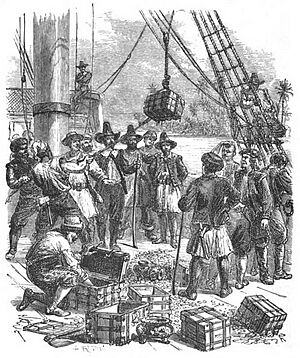
A famous story involves Sir William Phipps in 1687. He used a diving bell to find the wreck of a Spanish ship, Nuestra Señora de la Concepción, near what is now Haiti. His team salvaged a huge amount of jewels, gold, and silver, making him very rich!
In 1691, Edmond Halley (who discovered Halley's Comet!) made a much better diving bell. It could stay underwater for a long time. He added barrels of fresh air that could be sent down from the surface to refill the bell. Halley and five friends once stayed underwater in the River Thames for over an hour and a half! Later improvements allowed them to stay down for over four hours.
In 1789, engineer John Smeaton built the first working pump to send fresh air down to a diving bell. This was a big step forward.
Surface-Supplied Diving Gear
Early diving bells were good, but divers couldn't move around much. This led to the idea of sending air directly to the diver through a hose from the surface.
In 1602, a Spanish engineer named Jerónimo de Ayanz y Beaumont created an early diving suit. It was tested in Spain for King Philip the Third. In the early 1700s, Andrew Becker made a leather diving suit with a helmet and tubes for breathing. He stayed underwater for an hour in the River Thames. However, these early suits still didn't have a good way to keep the air fresh during the dive.
Open Diving Suits
In 1819, Augustus Siebe invented an open diving suit. It had a metal helmet attached to a waterproof jacket that ended at the diver's waist. Air was pumped into the helmet and escaped from the bottom of the jacket, like a small diving bell around the diver's head. Divers had to stay upright, or water would get in.
The first truly successful diving helmets were made by brothers Charles and John Deane in the 1820s. Charles first designed a "Smoke Helmet" for firefighters. In 1828, they changed it into a diving helmet. They added a loose "diving suit" to it. Divers could do salvage work, but again, they had to stay upright.
In 1829, the Deane brothers started their diving business. In 1834, Charles used his gear to recover 28 cannons from the sunken ship HMS Royal George. In 1836, John recovered items from the famous Mary Rose shipwreck. They even wrote the world's first diving manual!
Standard Diving Dress
The Deane brothers asked Augustus Siebe to make their helmet even better. In the 1830s, Siebe created a full-length, watertight canvas diving suit that attached to the helmet. This was a huge improvement! It became the standard diving dress, which changed underwater civil engineering, salvage, and commercial diving. Divers could now wear warm clothes underneath and stay dry.
Early Diving Jobs
In the early days, divers often cleaned and maintained ships. A clean ship could move faster! Divers would work for hours underwater, removing seaweed and other things from the hull. The British Navy started using diving suits in the 1860s for ship repairs, propeller cleaning, and finding lost anchors.
Salvage Diving Operations
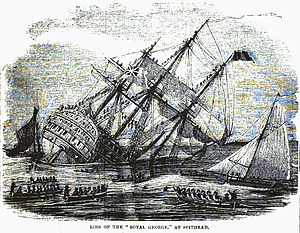
The sinking of the Royal George in 1782 was a big event for early diving. Charles Spalding used a diving bell to recover some cannons. Later, in 1839, Major-General Charles Pasley used the Deane brothers' new diving helmets to salvage more from the wreck.
Pasley's operation set many diving records. It was the first time divers were told to work in pairs, like a buddy system. Also, a diver had to make the first emergency swim to the surface after his air hose got tangled. Sadly, it also led to the first medical report of a diving injury caused by pressure changes. Early helmets didn't have a special valve, so if the hose broke, air would rush out, causing a dangerous pressure difference around the diver's head.
Pasley's team recovered many more cannons and parts of the ship over several years. By 1843, the wreck site was cleared.
Modernizing Surface-Supplied Gear
Over time, surface-supplied diving gear continued to improve. The US Navy developed special versions of the Mark V system for diving with helium-oxygen mixtures (called heliox). These were used successfully in 1939 to rescue the crew of the USS Squalus submarine. These helmets could recirculate breathing gas to save expensive helium.
In 1980, the US Navy replaced the Mark V with the Morse Engineering Mark 12 helmet. This helmet had a fiberglass shell and a large rectangular faceplate for better vision. It could also use mixed gases and was lighter.
Lightweight Demand Helmets
A big change came in 1964 when Joe Savoie invented the neck dam concept for diving helmets. This allowed the helmet to turn with the diver's head, making it much smaller and lighter. These new helmets used "demand valves," which only give the diver air when they breathe in, saving gas. The Kirby-Morgan Superlite helmets are a famous example of these lightweight demand helmets, which are very common in commercial diving today.
Self-Contained Diving Gear (Scuba)
The problem with surface-supplied gear was that divers were always connected to the surface by a hose. This limited their movement. People wanted a way for divers to carry their own air supply. Early attempts didn't work well because it was hard to store enough compressed air in small containers.
By the end of the 1800s, two main types of scuba (self-contained underwater breathing apparatus) were being developed:
- Open-circuit scuba: Where the diver's exhaled breath goes straight into the water.
- Closed-circuit scuba (rebreathers): Where the diver's breath is cleaned and reused.
Open-Circuit Scuba
In 1771, Sieur Fréminet of Paris designed an early self-contained breathing machine with an air reservoir. He used it successfully for over ten years. Other inventors like William H. James (1825) and Charles Condert (1831) also tried similar systems.
A major breakthrough came in 1864 with the invention of the demand regulator by French engineers Auguste Denayrouze and Benoît Rouquayrol. This device gave the diver air only when they needed it, making breathing much easier. However, it still needed a hose to the surface because air tanks couldn't hold enough high-pressure air yet.
The first truly self-contained open-circuit scuba system was created in 1925 by Yves Le Prieur in France. He used Michelin cylinders (like those for car tires) to hold compressed air. His "Fernez-Le Prieur" apparatus had a cylinder on the diver's back and a regulator that the diver adjusted by hand. Air flowed continuously, which meant it ran out quickly.
In 1933, Le Prieur replaced the goggles and nose clip with a full face mask that got a constant flow of air.
The most famous open-circuit scuba was invented in 1942 by Jacques-Yves Cousteau and Émile Gagnan during World War II. They called it the Aqua-Lung. They combined an improved demand regulator with high-pressure air tanks. This system was safe and successful, allowing divers much more freedom.
After the war, the Aqua-Lung was sold commercially starting in 1946. It became very popular and is the basis for most modern scuba gear. In 1952, Ted Eldred in Australia developed the single-hose open-circuit scuba system, which is what most divers use today. This design separated the regulator into two parts, making it more efficient.
Early scuba divers didn't have buoyancy aids. If they needed to go up quickly, they had to drop their weights. In the 1960s, adjustable buoyancy life jackets (ABLJ) became available. These jackets could be inflated to help divers control their position in the water and float safely on the surface. In 1971, the "direct system" allowed divers to inflate their jackets directly from their air tank, leading to the modern buoyancy compensator (device) (BCD).
Closed-Circuit Scuba (Rebreathers)
Another idea was to reuse the air the diver breathed. This is how a rebreather works. When you breathe out, you still have some oxygen left. A rebreather cleans the carbon dioxide from your exhaled breath and adds fresh oxygen, so you can breathe the same air again and again. This means you use less oxygen and don't make bubbles.
The first known oxygen rebreather was patented in 1808 by Sieur Touboulic. It used a sponge soaked in limewater to absorb carbon dioxide.
The first practical rebreather was designed by Henry Fleuss in 1878. It had a rubber mask connected to a bag with oxygen and a chemical to absorb carbon dioxide. This system could last for about three hours. Fleuss tested it himself and it was first used in 1880 by diver Alexander Lambert to close sluice doors in the Severn Tunnel. This was a very dangerous job for traditional divers because their air hoses could get tangled.
Robert Davis improved the oxygen rebreather in 1910 with his Davis Submerged Escape Apparatus (DSEA). It was first meant for submarine crews to escape, but it was also used for shallow diving. It could last for about 30 minutes.
In the 1930s, Italian spearfishers started using the DSEA. This led to the Italian Navy developing similar rebreathers for their combat swimmers, known as frogmen, during World War II. The British and Germans also used rebreathers for their frogmen because they don't make bubbles, which helps divers stay hidden.
In 1939, Christian Lambertsen developed an oxygen rebreather he called the Lambertsen Amphibious Respirator Unit (LARU). He later renamed it the Self Contained Underwater Breathing Apparatus, or SCUBA. After the war, military frogmen continued to use rebreathers for secret missions. Lambertsen also suggested using gas mixtures like helium and oxygen to allow divers to go deeper and reduce the need for long decompression stops.
Saturation Diving: Living Under Pressure

When divers go deep, their bodies absorb gases from their breathing air. If they come up too fast, these gases can form bubbles in their blood and tissues, causing a painful and dangerous condition called decompression sickness (also known as "the bends").
Saturation diving is a special technique for very deep and long dives. Once a diver's body has absorbed as much gas as it can (they are "saturated"), the time needed for decompression doesn't get longer, no matter how much more time they spend at that depth. This means divers can live in special pressurized habitats underwater for days or weeks. They only decompress once at the end of their mission, which saves a lot of time and makes deep work safer.
The first planned saturation dive happened in 1938. Two divers, Edgar End and Max Nohl, spent 27 hours breathing air at 30.8 meters (101 feet) in a special chamber. In 1957, George F. Bond started the Genesis project, proving that humans could live under high pressure for long periods. This led to the United States Navy's Man-in-the-Sea Program.
The first commercial saturation dives were done in 1965. Peter B. Bennett is known for inventing trimix (a breathing gas with helium, oxygen, and nitrogen) to help divers avoid problems at very deep depths. In 1981, divers in an experiment called Atlantis III went to a record depth of 686 meters (2,250 feet) and slowly decompressed over 31 days.
Saturation diving technology has become much safer over the years. Accidents are now very rare because of careful research and improved equipment and procedures.
Atmospheric Diving Suits: Dry and Safe
An atmospheric diving suit (ADS) is like a small, one-person submarine that you wear. It keeps the diver at normal surface pressure inside the suit, no matter how deep they go. This means the diver doesn't need to worry about decompression sickness. The challenge was making joints that could bend and stay watertight under extreme pressure.
Early Designs
In 1715, John Lethbridge built an enclosed "diving engine." It was a wooden barrel with armholes and a glass window. Air was sealed inside with the diver, and it could last for about half an hour. Lethbridge used it to salvage silver from shipwrecks, becoming quite wealthy.
The first armored suit with real joints was designed by W. H. Taylor in 1838. It had leather pieces with rings, like an accordion. However, it was never built because it would have been too heavy to move.
In 1882, the Carmagnolle brothers in France built one of the first human-shaped ADSs. It had 22 special joints that were supposed to be watertight. But it weighed 376 kg (830 lb) and never worked properly because the joints leaked. It's now in a museum in Paris.
In 1914, MacDuffy built the first suit to use ball bearings for joint movement, but it wasn't very successful. A year later, Harry L. Bowdoin designed an improved ADS with oil-filled rotary joints.
German firm Neufeldt and Kuhnke built ADSs that were used in the 1920s to salvage gold and silver from the wreck of the SS Egypt. These suits were mainly used as observation chambers to guide mechanical grabs. In 1917, Benjamin F. Leavitt salvaged copper ore from a wreck in Lake Huron using his own self-contained ADS, which had its own air tank and could last for an hour.
Peress' Tritonia
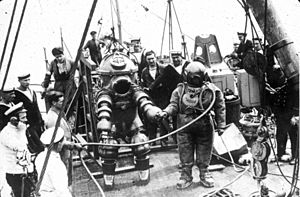
The first truly useful atmospheric diving suit was the Tritonia, invented by British engineer Joseph Salim Peress in 1932. He wanted to make a suit that kept divers dry and at normal pressure, even at great depths. Peress used lighter materials like cast magnesium and improved the joints with a cushion of oil. This oil allowed the joints to move smoothly even under high pressure.
In 1930, Peress showed off the Tritonia suit. In September, his assistant Jim Jarret dived in the suit to 123 meters (404 feet) in Loch Ness. The suit worked perfectly! The joints moved freely and didn't leak. The suit was offered to the Royal Navy, but they didn't think they needed it. In 1935, Jarret made a successful deep dive on the wreck of the RMS Lusitania.
The JIM Suit
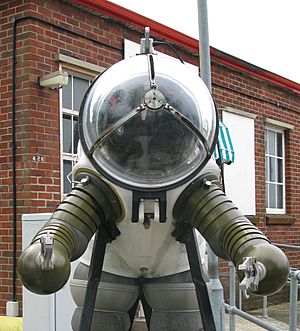
The Tritonia suit was later found and became the basis for the famous JIM suit, named after Jim Jarret. The first JIM suit was finished in 1971. It was made of cast magnesium and weighed about 500 kg (1,100 lb) in air. It could go to depths of 457 meters (1,500 feet).
In 1976, a JIM suit set a record for the longest working dive below 150 meters (490 feet), lasting almost six hours at a depth of 276 meters (905 feet). The JIM suit had special joints that allowed the diver to move their arms and legs. It also had a communication link and a life-support system that could last for about 72 hours.
Over time, JIM suits were improved. Magnesium was replaced with glass-reinforced plastic (GRP), and the joints were made even better, giving divers a wider range of motion. A clear top was added for a much better view. Some JIM suits were even designed to "fly" underwater using thrusters powered from the surface.
Newer ADS Designs
Other ADS designs followed. The SAM Suit was an all-aluminum model, smaller and lighter than the JIM. The JAM suit was made of GRP and could go to depths of 610 meters (2,000 feet).
In 1987, Canadian engineer Phil Nuytten developed the "Newtsuit." It was designed to be like a "submarine you can wear," allowing divers to work at normal pressure even at depths over 300 meters (1,000 feet). It was made of aluminum and had fully moving joints. The Newtsuit was used to salvage the bell from the famous wreck of the SS Edmund Fitzgerald in 1995. Nuytten's newer design, the Exosuit, is lighter and used for marine research.
The ADS 2000 was developed in 1997 for the US Navy. It's an improved version of the Newtsuit, made of strong aluminum alloy. It can operate down to 610 meters (2,000 feet) for six hours and has its own life support and thrusters for movement. It became fully operational in 2006.
Physiological Discoveries: Understanding the Body Underwater
When a diver goes deeper, the pressure around them increases. The air they breathe also gets compressed. Some of the gases from this air dissolve into the diver's blood and tissues. If the diver comes up too quickly, these dissolved gases can form bubbles. These bubbles can cause damage to tissues, leading to decompression sickness (DCS), also known as "the bends." Symptoms can include pain, dizziness, and even paralysis.
Scientists have studied DCS for a long time to understand how to prevent it. They learned that slow decompression, with stops at different depths, allows the gases to leave the body safely.
Robert Boyle was one of the first to study how pressure affects living things in the 1600s. Later, in the 1800s, workers in pressurized tunnels (called caissons) started getting "caisson disease" or "the bends." They realized that putting the workers back under pressure could help.
French scientist Paul Bert was the first to truly understand decompression sickness in 1878. He figured out that breathing pressurized air caused nitrogen to dissolve in the blood. If the pressure dropped too fast, the nitrogen would turn back into gas bubbles, which could block blood flow.
John Scott Haldane designed a decompression chamber in 1907 to make deep-sea diving safer. In 1908, he created the first decompression tables for the Royal Navy. These tables showed divers how to come up in stages, which is still the basis for safe decompression today. Thanks to Haldane's work, divers could safely go down to 60 meters (200 feet).
The US Navy continued this research, developing their own decompression tables. They also studied using oxygen during decompression and doing decompression stops in the water. Today, decompression is much safer, but it still has some risks. Scientists continue to study how bubbles form and how to make diving even safer.
Images for kids




